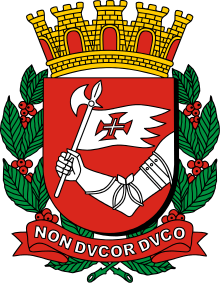São Paulo Metro
The São Paulo Metro (Portuguese: Metrô de São Paulo), commonly called the Metrô (Portuguese pronunciation: [meˈtɾo]) is one of the urban railways that serves the city of São Paulo, alongside the São Paulo Metropolitan Trains Company (CPTM), forming the largest metropolitan rail transport network of Latin America.[7] The six lines in the metro system operate on 101.1 kilometres (62.8 mi) of route, serving 89 stations.[8] The metro system carries about 5,300,000 passengers a day.[9]
 | |||
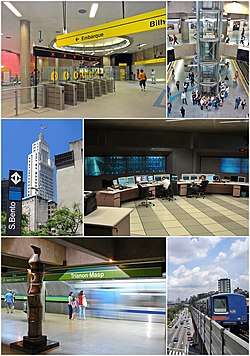 | |||
| Overview | |||
|---|---|---|---|
| Native name | Metrô de São Paulo | ||
| Locale | São Paulo, Brazil | ||
| Transit type | Rapid transit | ||
| Number of lines | 6 | ||
| Line number | 1 2 3 4 5 15 | ||
| Number of stations | 89 | ||
| Daily ridership | 5.3 million (2019) | ||
| Annual ridership | 1.494 billion (2019)[1][2][3][4] | ||
| Website | Metrô (in English) | ||
| Operation | |||
| Began operation | September 14, 1974 | ||
| Operator(s) | |||
| Headway | 1′40" to 3′ | ||
| Technical | |||
| System length | 101.1 km (62.8 mi)[5](Metro only) 374 km (232 mi)[6] (complete network) | ||
| Track gauge | 1,600 mm (5 ft 3 in) (Lines 1-3) 1,435 mm (4 ft 8 1⁄2 in) (Lines 4-5) | ||
| Electrification | |||
| Average speed | 60 km/h (37 mph) | ||
| Top speed | 100 km/h (62 mph) (Lines 1-3) 80 km/h (50 mph) (Lines 4-5, 15) | ||
| |||
Metro itself is far from covering the entire urban area in the city of São Paulo and only runs within the city limits. However, it is complemented by a network of metropolitan trains operated by CPTM, which serve the São Paulo and the São Paulo Metropolitan Region.[10][11] The two systems combined form a 374 km (232 mi) long network.[12] The CPTM differs from Metro because it also serves other municipalities around São Paulo with larger average distance between stations and freight trains operating in some lines (except for the Line 9, which has almost no differences to the Metro lines).
Considered the most modern in Latin America[13], the system is the first to install platform screen doors at a station[14], and use communications-based train control[15] with lines 4 and 15 being fully automated.[16] Line 15, is a monorail line that partially opened for service in 2014 and is the first high capacity monorail line of Latin America. The São Paulo Metro and CPTM both operate as State-owned companies, and have received awards in the recent past as one of the cleanest systems in the world by ISO9001.[17] The São Paulo Metro was voted Best Metro Americas at the MetroRail 2010 industry conference[18] and it was chosen as one of the best metro systems of the world by the Business Insider, being the only system in Latin America to make the list.[19]
History
The Companhia do Metropolitano de São Paulo (Metrô) was founded on April 24, 1968. Eight months later, work on North-South line was initiated. In 1972, the first test train trip occurred between Jabaquara and Saúde stations. On September 14, 1974, the segment between Jabaquara and Vila Mariana entered into commercial operation.
The first line, Norte/Sul (North/South), later renamed "Blue Line" or Line 1 - Blue, was opened on September 18, 1972, with an experimental operation between Saúde and Jabaquara stations. Commercial operations started on September 14, 1974, after an eight-year "gestation" period that began in 1966, under Mayor Faria Lima's administration. Expansion of the metro system includes new lines. As of late 2004, construction began on a US$1 billion, 12.8 km (8.0 mi) all-underground line (Line 4 - Yellow), with eleven stations, aimed at transporting almost one million people per day. By 2004, Line 2 was also being expanded, with two new stations open in 2006 and another one in 2007.
An 10.5-kilometre (6.5 mi) expansion of Line 5 was completed in 2018.
As of January 2020, tickets cost R$4.40. In 2006, the São Paulo Metro system has started to use a smart card, called "Bilhete Único" (or "Single Ticket" in English).
Current operational data
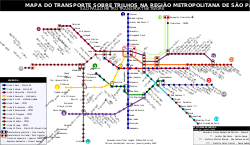
The metro system consists of six color-coded lines: Line 1 (Blue), Line 2 (Green), Line 3 (Red), Line 4 (Yellow), Line 5 (Lilac) and Line 15 (Silver), operating from Sunday to Saturday, from 4:40 AM to midnight (1:00 AM on Saturdays).[20] Line 15 (Silver), is a high-capacity monorail.
The six lines achieved an average weekday ridership of 5.3 million in 2019[9]. On 14 September 2019, Metrô recorded the highest ever ridership figure of 5.5 million on a single business day, caused by the recent expansion of some lines. The Metro provided 1,4945 billion rides over the course of 2019.[1]
Bus terminals
In May 1977, Metro assumed the administration and commercial utilization of the Inter-City Jabaquara Intermunicipal Terminal, and inaugurated, in May 1982, the modern Inter-city Tietê Bus Terminal, replacing the former Júlio Prestes Terminal.
This agreement established that Metro would be in charge of the studies for the planning, implementation, and operation of passenger transportation in the municipal district of São Paulo, either directly or through third parties.
Later, the other inter-city bus terminals were integrated into the system, such as Bresser, in January 1988, and Palmeiras-Barra Funda, in December 1989. In January 1990 the inter-city bus terminals were outsourced by Metrô, which through public bidding, contracted Consortium Prima for the administration and commercial utilization of the 4 inter-city bus terminals of the city of São Paulo. This contract included the responsibility for maintenance and conservation of the existing installations, as well as of the expansion and modernisation of the terminals.[21]
Rolling stock
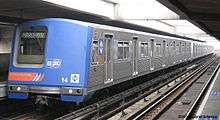
The first cars started operating in 1974, the same year the company's commercial activities were initiated. This model was named Series 100, whose cars received the numbers of 1001 to 1306 (51 trains of 6 cars each). They were designed in United States by the Budd Company, and the national rolling stock manufacturer Mafersa did the final assembly. The model was based off the Class A trains from the BART system, even using the same Westinghouse 1460 series chopper traction controls, and was to be used along the North-South line, now known as Line 1 - Blue. The initially they operated with two car trains with cars added as demand increased, up to a maximum of six cars. All of them have a pair of electric motors and a cab.
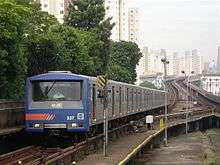
Today, this stock is known by "A stock" and all operate in the full six car consists. The entire "A stock" was planned to be entirely phased out by the beginning of 2015, as the recent modernization processes saw them being converted into two different stocks: I and J. The last A stock train was withdrawn from service in February 2018.
To reduce the manufacturing costs, the Cobrasma company decided to provide, for the East-West Line, now Line 3. Trains had cabs only and made use of more advanced ventilation and maintenance systems. This stock was known by the name of "C". The batch of trains designed for this line were produced by two different national companies, Cobrasma and Mafersa (whose trains got named as "D"). The trains entered service between 1984 and 1986 on Line 3 and remained there for their entire service lives, although in their final years, some of the D stock trains were transferred to Line 1 where they ran with the older A stock trains.
.jpg)
The only difference between the two is the front mask and some structural framework. Their original technical nomenclature was 300. According to it, the C stock was numbered from 301 (C01) to 325 (C25), and the D stock had trains numbered from 326 (D26) to 347 (D47). The C stock trains were already refurbished as K stock and the D stock was refurbished and created the L cars. The refurbishment program for the entire stock of A, C and D trains was completed in 2018.
Today the rolling stock of the São Paulo Metro consists of 11 stocks, 232 trains[1] and 1,419 cars[22] and it is divided as follows:
E stock: Built by Alstom and entered service between 1998 and 1999. They currently operate on Line 1 - Blue.
F stock: Alstom trains specially built for Line 5 - Lilac between 2001 and 2002.
G stock: Also built by Alstom and entered service in 2008. They currently run on Lines 1 - Blue and 3 - Red.
H stock: Streamlined CAF-built trains built in 2010 which operate exclusively on Line 3 - Red since 2014.
I and J stock: Refurbished A stock trains which operate on Lines 1 - Blue and 2 - Green from 2011. They differ cosmetically as well as mechanically. I stock was rebuilt by Alstom and Siemens while J stock was rebuilt by Bombardier, Temoinsa, BTT and Tejofran.
K stock: Refurbished C stock trains rebuilt by a consortium consisting of T’trans, MTTrens, MPE and Temoinsa. They operate on Line 3 - Red just like the original trains.
L stock: D stock refurbished by Alstom and IESA and operates on Line 1 - Blue
M stock: The Monorail stock built by Bombardier between 2013 and 2016 and operates on Line 15 - Silver.
P stock: CAF-built trains from 2013 which run on Line 5 - Lilac alongside the former F stock.
400 series: Driverless trains built in 2009-2010 and 2016-2017 by Hyundai Rotem for Line 4 - Yellow [23]
Security
Metro's security agents have police powers and in case of need they will provide assistance. All police matters that occur within the system are directed to the police station of the subway system, DELPOM (Delegacia de Polícia do Metropolitano de São Paulo), located at Palmeiras-Barra Funda station.[24]
System lines
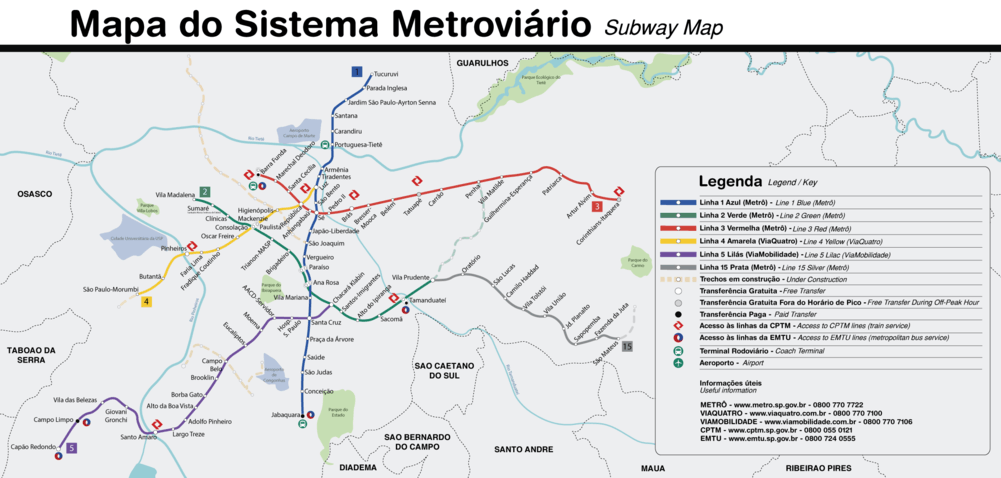
| Line | Color | Termini | Opened | Length | Stations | Duration of trip (min) |
Hours of Operation |
|---|---|---|---|---|---|---|---|
| Line 1 | Blue | Tucuruvi ↔ Jabaquara | September 14, 1974 | 20.2 km (12.6 mi)[25] | 23 | 39 | Daily (4:40 AM–0:32 AM) |
| Line 2 | Green | Vila Madalena ↔ Vila Prudente | January 25, 1991 | 14.7 km (9.1 mi)[25] | 14 | 26 | Daily (4:40 AM–0:32 AM) |
| Line 3 | Red | Palmeiras-Barra Funda ↔ Corinthians-Itaquera | March 10, 1979 | 22.0 km (13.7 mi)[25] | 18 | 34 | Daily (4:40 AM–0:32 AM) |
| Line 4[26] | Yellow | São Paulo-Morumbi ↔ Luz | May 25, 2010 | 11.4 km (7.1 mi)[27] | 10 | 19 | Daily (4:40 AM–0:32 AM) |
| Line 5[28] | Lilac | Capão Redondo ↔ Chácara Klabin | October 20, 2002 | 19.9 km (12.4 mi)[29] | 17 | 35 | Daily (4:40 AM–0:32 AM) |
| Line 15 | Silver (Monorail) |
Vila Prudente ↔ São Mateus | August 30, 2014 | 12.8 km (8.0 mi)[25] | 10 | 21 | Daily (4:40 AM–0:32 AM) |
Future developments
Several conventional metro and monorail lines are currently under construction or under project.
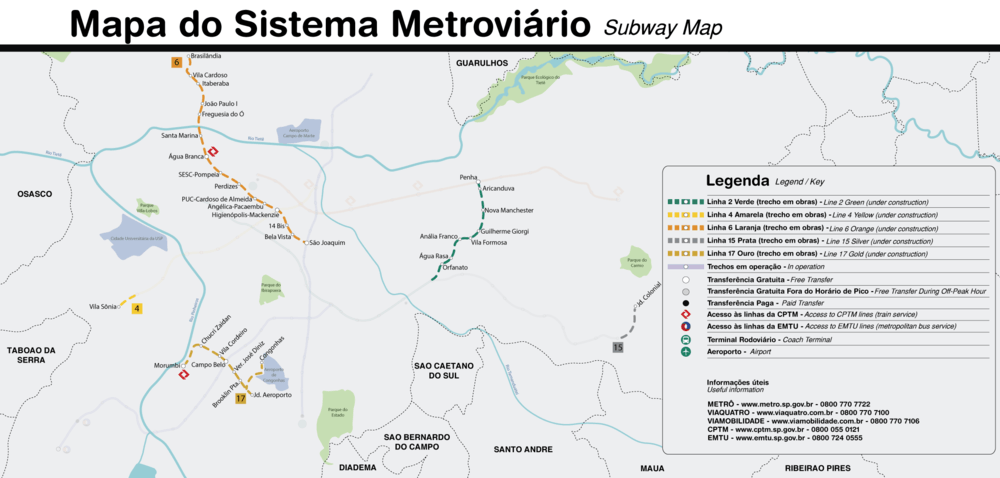
| Line | Color | Termini | Length | Stations |
|---|---|---|---|---|
| Line 2[30][31] | Green (Expansion) | Vila Prudente ↔ Penha | 8.3 km (5.2 mi) | 8 |
| Line 4[26][32] | Yellow (Expansion) | Vila Sônia | 1.5 km (0.93 mi) | 1 |
| Line 15[33] | Silver (Monorail) (Expansion) | São Mateus ↔ Jardim Colonial | 1.8 km (1.1 mi) | 1 |
| Line 17[34] | Gold (Monorail) | Morumbi ↔ Jardim Aeroporto | 6.7 km (4.2 mi) | 8 |
| Line | Color | Termini | Length | Stations |
|---|---|---|---|---|
| Line 6[35] | Orange | Brasilândia ↔ São Joaquim | 13.4 km (8.3 mi) | 15 |
| Line | Color | Termini | Length | Stations |
|---|---|---|---|---|
| Line 2[30] | Green (Expansion) | Penha ↔ Dutra | 5 km (3.1 mi) | 5 |
| Line 2[30] | Green (Expansion) | Vila Madalena ↔ Cerro Corá | 1 km (0.62 mi) | 1 |
| Line 4[26][32] | Yellow (Expansion) | Vila Sônia ↔ Largo do Taboão | 3 km (1.9 mi) | 2 |
| Line 5[28] | Lilac (Expansion) | Capão Redondo ↔ Jardim Ângela | 4 km (2.5 mi) | 3 |
| Line 5[28] | Lilac (Expansion) | Chácara Klabin ↔ Ipiranga | 3 km (1.9 mi) | 2 |
| Line 15 | Silver (Monorail) (Expansion) | Jardim Colonial ↔ Cidade Tiradentes | 9.2 km (5.7 mi) | 6 |
| Line 15 | Silver (Monorail) (Expansion) | Ipiranga ↔ Vila Prudente | 1.9 km (1.2 mi) | 1 |
| Line 16[36][37] | Violet | Oscar Freire ↔ Jardim Brasília | 20 km (12 mi) | 21 |
| Line 17[34] | Gold (Monorail) (Expansion) | Morumbi ↔ São Paulo-Morumbi | 6.4 km (4.0 mi) | 5 |
| Line 17[34] | Gold (Monorail) (Expansion) | Jardim Aeroporto ↔ Jabaquara | 3.5 km (2.2 mi) | 5 |
| Line 19[38][39][40] | Sky Blue | Bosque Maia ↔ Anhangabaú | 17.6 km (10.9 mi) | 15 |
| Line 20[39][37] | Pink | Santa Marina ↔ Santo André | 31 km (19 mi) | 24 |
| Line | Color | Termini | Length | Stations |
|---|---|---|---|---|
| Line 18[41][42] | Bronze (Monorail) | Tamanduateí ↔ Djalma Dutra | 14.9 km (9.3 mi) | 13 |
| Line 21[43] | Gray | Pari ↔ Nordestina | 21 km (13 mi) | 12 |
| Line 22[44][45][46][47][37] | Maroon | Rebouças ↔ Granja Viana | 16.1 km (10.0 mi) | 13 |
| Line 23[37][48][49][50] | Magenta | Lapa ↔ Dutra | 17 km (11 mi) | 20 |
| Line 24[51] | Color unknown | São Paulo ↔ Diadema | ||
See also
- List of São Paulo Metro stations
- Companhia do Metropolitano de São Paulo - São Paulo Metropolitan Company
- Companhia Paulista de Trens Metropolitanos - São Paulo Metropolitan Trains' Company
- Trens Intercidades - planned regional rail network centred on São Paulo
- Transport in São Paulo
- List of Latin American rail transit systems by ridership
- List of metro systems
- List of monorail systems
- Rapid transit in Brazil
References
- "Relatório Integrado 2019" [Integrated Report 2019] (PDF) (in Portuguese). Companhia do Metropolitano de Sao Paulo. 2020. Retrieved 2020-05-22.
- http://transparencia.metrosp.com.br/dataset/demanda"Companhia do Metropolitano de São Paulo
- https://www.viamobilidade.com.br/linhas/passageiros-transportados
- http://www.viaquatro.com.br/linha-4-amarela/passageiros-transportados
- "Governo de SP entrega 3 novas estações do Metrô" (in Portuguese). 16 December 2019. Retrieved 16 December 2019.
- Ricardo Meier (29 October 2018). "Estação São Paulo-Morumbi coloca a Linha 4 mais próxima da periferia" (HTML) (in Portuguese). Retrieved 19 February 2019.
- http://www.urbanrail.net/am/spau/sao-paulo.htm
- "Estação São Paulo-Morumbi do Metrô recebe visita técnica". Governo do Estado de Sao Paulo. 2018. Retrieved 2018-11-14.
- "Com demanda em alta, linhas de metrô já transportam mais de 5,3 milhões de pessoas por dia" [With rising demand, subway lines already transport more than 5.3 million people a day] (in Portuguese). metrocptm. 2019. Retrieved 2019-12-23.
- Metropolitan Map of São Paulo
- Expansion Archived January 30, 2010, at the Wayback Machine
- https://www.metrocptm.com.br/estacao-sao-paulo-morumbi-coloca-a-linha-4-mais-proxima-da-periferia/
- Government of Sao Paulo State (30 January 2010). "Serra inaugura estação Sacomã do Metrô" [Governor Serra opens Metro station Sacoma] (in Portuguese). Retrieved 25 December 2019.
- http://www.saopaulo.sp.gov.br/spnoticias/ultimas-noticias/serra-inaugura-estacao-sacoma-do-metro-1
- http://www.revistaferroviaria.com.br/index.asp?InCdNewsletter=5547&InCdUsuario=23745&InCdMateria=11225&InCdEditoria=1
- Sitio de ViaQuatro, see section Technology
- http://www.metro.sp.gov.br/metro/institucional/certificacao.aspx
-
- "9 Of The World's Best Subways (PHOTOS)". Huffington Post. April 12, 2010.
- "ABN+NEWS AGENCIA BRASILEIRA DE NOTICIAS - ABN NEWS BRAZILIAN NEWS AGENCY". Retrieved 7 February 2017.
- "Terrapinn - conference, exhibitions & industry awards". 1 May 2015. Archived from the original on 22 August 2012. Retrieved 7 February 2017.
- "Metrô - Companhia do Metropolitano de São Paulo". Retrieved 7 February 2017.
- Business Insider (24 August 2015). "This graphic compares the best public transportation systems around the world" (SHTML). Retrieved 5 April 2018.
- "Horários - funcionamento | Metrô São Paulo". www.metro.sp.gov.br (in Portuguese). Retrieved 2018-08-08.
- "Metrô - Companhia do Metropolitano de São Paulo". Retrieved 7 February 2017.
- Includes 1,245 cars reported in February 2018 by the Metro, and additional 174 cars (29 trains) of Line 4 - Yellow.
- https://www.metrocptm.com.br/linha-4-amarela-esta-prestes-a-receber-novos-trens/
- "Metrô - Companhia do Metropolitano de São Paulo". Retrieved 7 February 2017.
- "Infraestrutura" (PDF). Portal de transparência e governança corporativa da Companhia do Metropolitano de São Paulo. November 2019. Retrieved January 3, 2020.
- "Obras de expansão da Linha 4-Amarela - Metrô São Paulo". Retrieved 7 February 2017.
- "Sobre a Linha 4 Amarela | ViaQuatro". www.viaquatro.com.br. Retrieved 2020-01-04.
- "Obras de expansão da Linha 5-Lilás - Metrô São Paulo". Retrieved 7 February 2017.
- "ViaMobilidade completa 1 ano operando a Linha 5-Lilás". www.viamobilidade.com.br. Retrieved 2020-01-04.
- https://web.archive.org/web/20091015233144/http://www.expansao.sp.gov.br/metro_linha_branca.php. Archived from the original on October 15, 2009. Retrieved December 21, 2009. Missing or empty
|title=(help) - Bertoloto, Bernardo (17 January 2020). "Governo anuncia retomada da expansão da Linha Verde do Metrô prometida para 2013" (in Portuguese). G1. Retrieved 19 January 2020.
- Sioux, Maddox (7 February 2017). "Expansão São Paulo: Linha 4 Amarela viaQuatro". Retrieved 7 February 2017.
- "Monotrilho Linha 15-Prata - Metrô São Paulo". Retrieved 7 February 2017.
- "Obras de expansão da Linha 17-Ouro - Metrô São Paulo". Retrieved 7 February 2017.
- https://web.archive.org/web/20091016163651/http://www.expansao.sp.gov.br/metro_linha_laranja.php. Archived from the original on October 16, 2009. Retrieved December 21, 2009. Missing or empty
|title=(help) - (PDF) https://www.pdui.sp.gov.br/rmsp/wp-content/uploads/2016/05/PDUI-STM-RedeAltaMediaCapacidade-11-05-2016.pdf. Retrieved 16 January 2019. Missing or empty
|title=(help) - SP, Márcio PinhoDo G1 (12 August 2012). "Metrô contrata estudos para três novas linhas na Zona Norte de SP". São Paulo (in Portuguese). Retrieved 16 January 2019.
- "PDUI-STM-RedeAltaMediaCapacidade-11-05-2016.pdf" (PDF). Retrieved 16 January 2019.
- http://www.domboscoitaquera.org.br/downloads/secretaria_estadual_de_transportes.pdf Seminário sobre infraestrutura e sistema viário para a copa 2014 e o desenvolvimento da zona leste, Jurandir Fernandes, Secretário dos Transportes Metropolitanos, 25/08/2011
- "Metrô contrata estudos para três linhas an zona norte de SP".
- http://www.aeamesp.org.br/bblt/16s/d4programa.aspx Associação dos Engenheiros e Arquitetos do Metrô de S. Paulo - 16ª Semana da Tecnologia Metroferroviária - 16 de setembro de 2010, Palestra : Metroleve ABC-SP
- Meier, Ricardo (3 July 2019). "Governo do estado cancela Linha 18-Bronze de metrô" (in Portuguese). Metrô CPTM. Retrieved 15 July 2019.
- (PDF) https://www.pdui.sp.gov.br/rmsp/wp-content/uploads/2016/05/PDUI-STM-RedeAltaMediaCapacidade-11-05-2016.pdf. Retrieved 16 January 2019. Missing or empty
|title=(help) - https://www.google.com/search?q=metr%C3%B4+linha+22+bordo. Retrieved 16 January 2019. Missing or empty
|title=(help) - https://viatrolebus.com.br/2018/11/nova-linha-de-metro-entre-cotia-e-sao-paulo/. Retrieved 16 January 2019. Missing or empty
|title=(help) - "Quando o Metrô chegará a outra cidade da Grande São Paulo?". Metrô CPTM (in Portuguese). 10 September 2016. Retrieved 16 January 2019.
- https://www.jornalcotiaagora.com.br/metro-sp-cotia-projeto-funcional-da-linha-22-esta-atrasado-e-tera-aumento-de-estacoes/. Retrieved 16 January 2019. Missing or empty
|title=(help) - (PDF) https://www.pdui.sp.gov.br/rmsp/wp-content/uploads/2016/05/PDUI-STM-RedeAltaMediaCapacidade-11-05-2016.pdf. Retrieved 16 January 2019. Missing or empty
|title=(help) - https://viatrolebus.com.br/2012/08/metro-licita-projeto-funcional-para-linha-23-que-vai-ligar-a-dutra-ate-a-lapa/. Retrieved 16 January 2019. Missing or empty
|title=(help) - https://viatrolebus.com.br/2013/12/rede-futura-do/. Retrieved 16 January 2019. Missing or empty
|title=(help) - https://plamurbblog.wordpress.com/2018/12/19/metro-divulga-quais-serao-as-linhas-em-projeto-na-proxima-decada/. Retrieved 16 December 2019. Missing or empty
|title=(help)
External links
| Wikimedia Commons has media related to São Paulo Metro. |

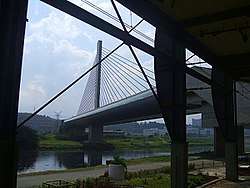
.jpg)
